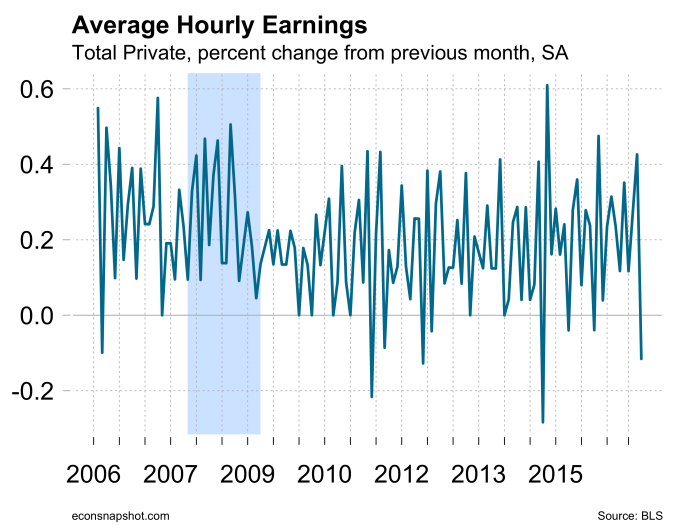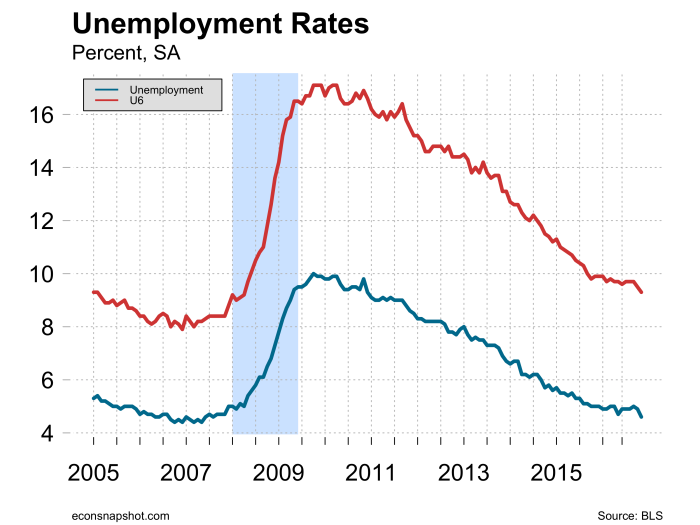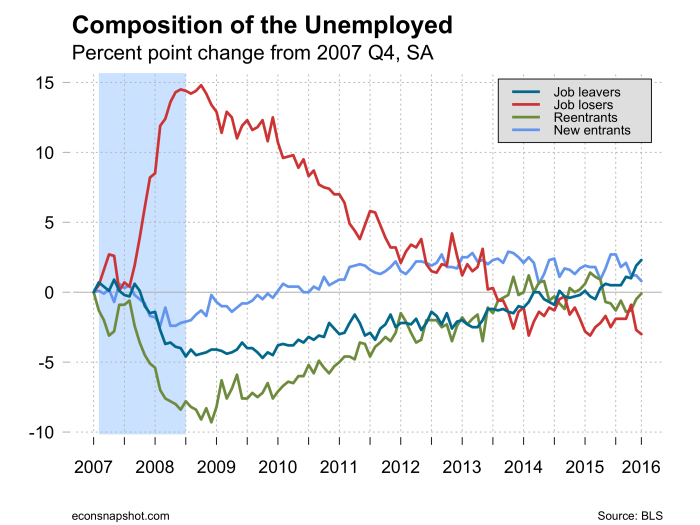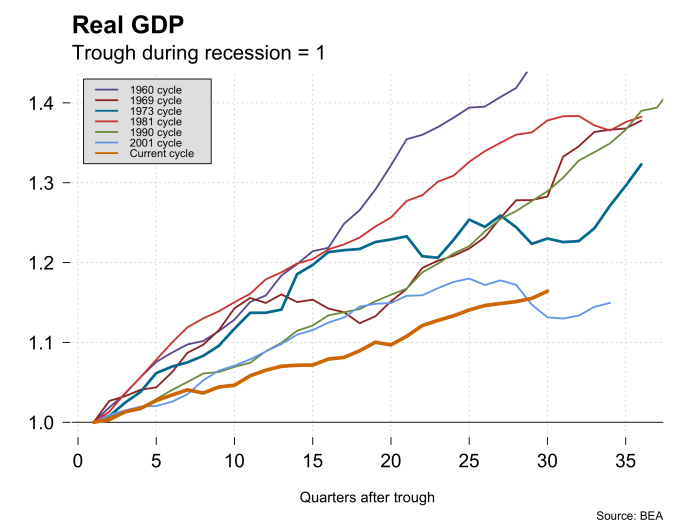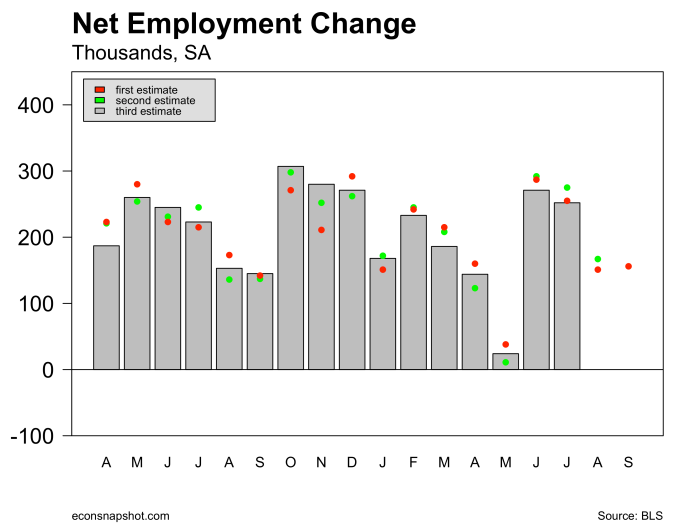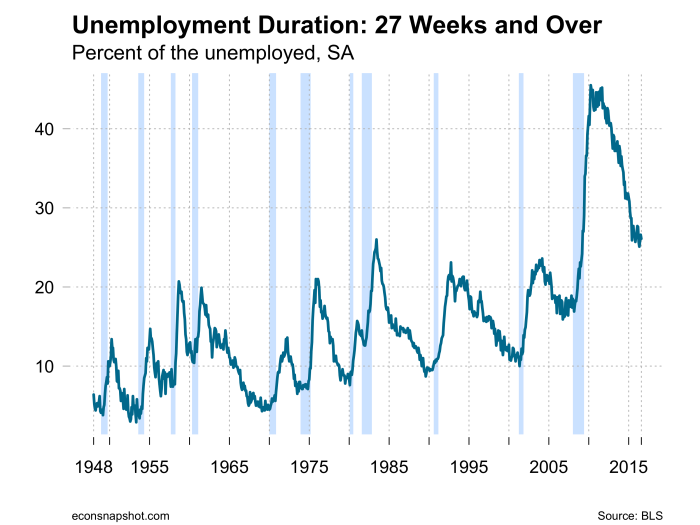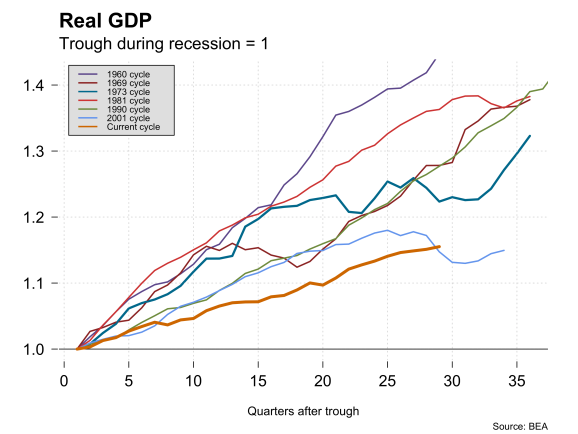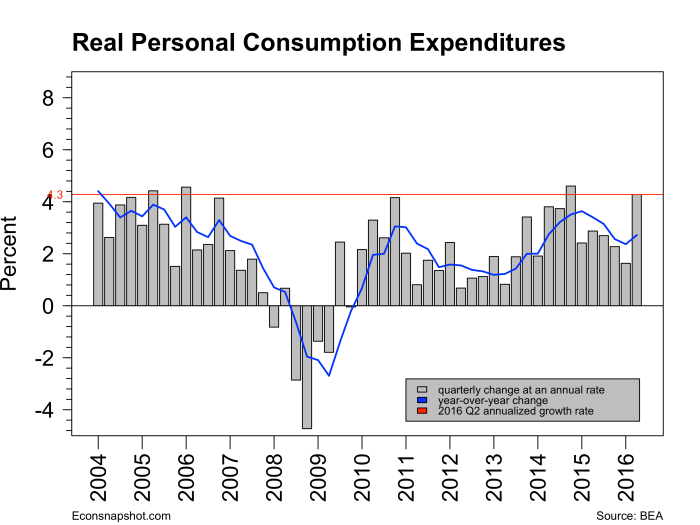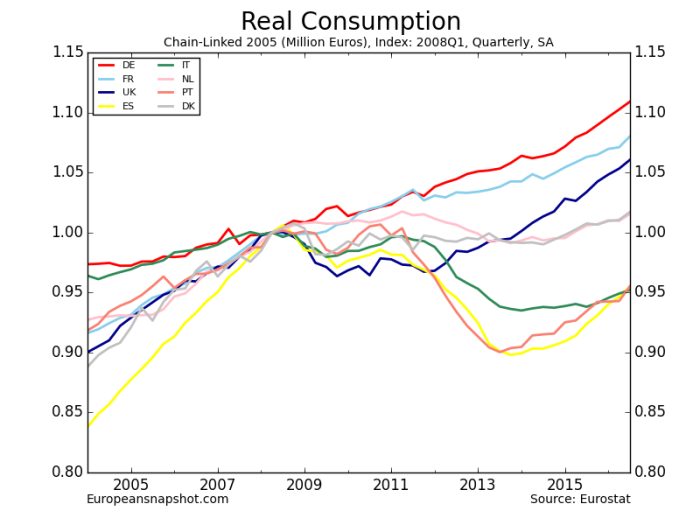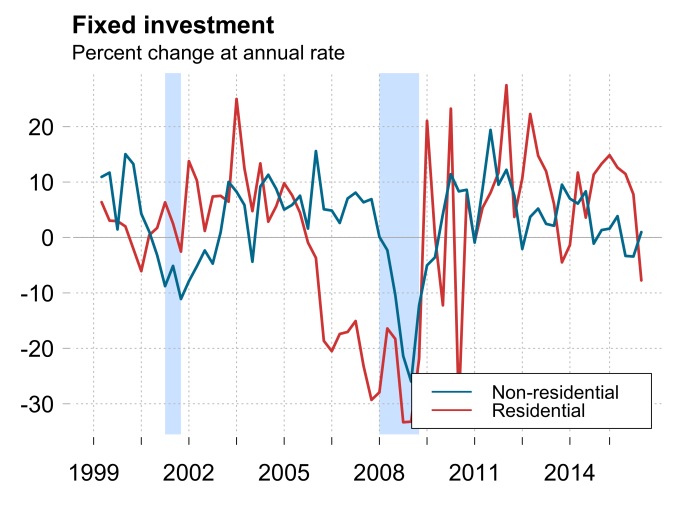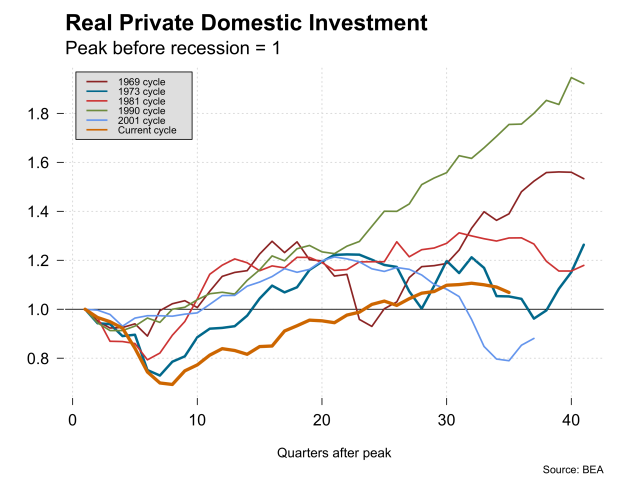By Thomas Cooley, Ben Griffy, and Peter Rupert
At the start of Nov. 8th, most pundits would have been equally shocked by a Donald Trump victory as they would have been by Harry Truman rising from his grave clutching a newspaper celebrating his 1948 electoral victory. Almost universally, onlookers predicted a large, if not resounding victory for Hillary Clinton. And now a week later, many of those pundits have begun to acknowledge their own hubris in their predictions.
We take the opportunity to explore this and the past several elections, to see what differences might have driven such an unexpected outcome. What we find is interesting: Once we control for the level of education and unemployment in a county, the proportion of white men in a county was not predictive of a higher likelihood of voting for Trump. Counties with higher unemployment and less education were much less likely to vote for the Democratic ticket than they were in 2012, while all race and gender groups appear to have been more likely to increase their vote for Clinton once demographics were included. Additionally, counties that were heavily employed in manufacturing closer to the enactment of NAFTA swung their vote away from Clinton and may have decided the election.
To do this analysis, we combined county-level election results for the previous two elections, 2012 and 2016, with a number of characteristics of those counties, including race and gender, education, unemployment, and employment by industry (2-digit), for the most recent years available (most often 2015). We also include the percent of the county employed in manufacturing jobs for the year 2002 (the earliest year available at the county level) to assess whether a narrative about NAFTA and trade may have had a role in determining the outcome of the election. We further merge information on the counties previously covered by the Voting Rights Act (prior to the Shelby decision, 2013) to see what impact lifting the pre-clearance requirement may have had on the election.
As one might expect, there is a strong geographic component to the outcome of the election. The coasts strongly supported Clinton, while the center overwhelmingly supported Trump:


An interactive version of the maps presented here, as well as instructions on how to use them are available at the bottom of the post. There are subtle, but important differences between the geographic distribution of votes in these two elections. Notably, Democratic losses were concentrated in areas that were strongholds as recently as 2012:

What drove these differences? There’s no doubt that the results are, at least to some degree, consequence of an undertow of racism, sexism, and homophobia, that voters were able to exorcise from the privacy of the voting booth. It’s also true Hillary Clinton was also an historically unpopular candidate, exceeding only her rival in popularity among presidential candidates. But it also seems that the economically dispossessed were willing to overlook these flaws to support Trump. The table below reports the marginal effect that a one percent change in a set of covariates had on the support for Clinton relative to Obama. We measure this change in support as the percent in a county voting for Clinton in 2016 minus the percent in that county that voted for Obama in 2012. The covariates are all the same scale, between 0 and 100, meaning that a 10 percent increase in the unemployment rate in a county implies a 5 percent decrease in support for Clinton relative to Obama in 2012 (see the number corresponding to unemployment in the table below). We also use state fixed effects, meaning that these results are relative to the average change in the state.

A quick read of this table reveals some interesting, and potentially surprising statistics. Counties with higher percentages of Hispanic and Latino voters turned out for Clinton, while counties with higher unemployment aligned with Trump’s populist message. The African American vote did not seem to improve Clinton’s outcomes, and we discuss some causes for this below. As has already been widely reported, counties with higher percentages of white men were more likely to support Trump, relative to 2012, which is shown by the cross-term in row 3 (remember that each variable is 0 to 100, so the cross-term ranges from 0 to 10000, potentially). There is an important subtlety here: once county-level demographic and economic characteristics are controlled for, counties with white men actually increased their vote for Clinton relative to how they voted in 2012, for almost all the combinations of percent male and percent white in the dataset. However, the cross-term in row 3 indicates that as either the percent white or percent male in a county increased, the margin got smaller, suggesting that highly white or male counties were less likely to vote for Clinton than their more diverse peers. Still, for all but the most white counties in the dataset, our model would predict that they would increase their vote for Clinton, relative to Obama in 2012. The dichotomy between what we see in our dataset and what we observed in the election is that the places that were overwhelmingly white and changed their votes to Trump also have higher rates of unemployment and higher percentages of residents with a high school degree or less. Nationally, the distribution of white males is shown below (counties in gray did not have the relevant data):

This seems at least geographically consistent with the narrative that white men swung the election for Trump. Our interpretation is that covariates that might be strongly correlated with certain geographic regions, like unemployment and education, are strongly correlated with support for Trump. As shown above, those with a high school education or less strongly decreased their support for Clinton relative to their support for Obama in 2012. That distribution geographically is displayed here:

Again, it appears that these groups are concentrated in states that had a substantial impact on the election, though not as densely as one might expect. Somewhat surprisingly, repeating the analysis above with a variable that represents the percent of counties with white men with a high school education or less does not yield significant results, that is at least partially suggestive that the most common narrative following the election, that low-education white male voters swung states from Clinton to Trump isn’t consistent with the data. Again, this is probably because there is a strong correlation between these groups and other characteristics. The result that we find most interesting comes from the variable labeled “Percent Employed in Manufacturing (2002),” the earliest year for which employment by sector is available at the county level. This means that counties with higher percentages of their workers employed in manufacturing sectors in 2002 were substantially less likely to vote for Clinton than they were for Obama just four years before. This could of course simply be correlation, but it’s also possible that these workers still hold the Clinton’s responsible for declining job prospects as a result of NAFTA in 1994. Where were these industries located? See below:

We see that the percentage of individuals employed in manufacturing is fairly evenly distributed among states in the Midwest and the South. Remember that several key states in the election, Pennsylvania, Wisconsin, and Michigan, were decided by about 1.5 percent or less of the total vote, meaning that the shift in voting in these manufacturing heavy counties could have played a large role. Equally as important as the percent employed in manufacturing is the number of potential voters who were employed in these industries, and where they were located:

Unfortunately, many counties lack data on share of manufacturing from the 2002 data source. From the data we can obtain, counties that switched votes from Democrat to Republican, those in the Midwest had higher percentages of their workforce employed in manufacturing, and larger numbers employed in those industries as well. Furthermore, these industries were highly concentrated in the “Rust Belt,” the states closest to the Great Lakes. These states had been traditional Democratic strongholds, but swung to the Republicans for the first time in several elections. With this data, we can only conjecture about whether this was a cause, but it does appear that counties with jobs that were more likely to leave following the adoption of NAFTA shifted their votes in large quantities to the Republican ticket.
Another interesting and important narrative in this election is the removal of the Voting Rights Act as a protection against impeding voter participation. Could this also have played a role in swinging the election? Prior to Shelby County v. Holder (2013), which ruled the pre-clearance requirement unconstitutional, there were a number of jurisdictions under the purview of Section 5 of the Voting Rights Act (link). When we repeat the same exercise as before, predicting the percent change in Democratic support within a county between 2016 and 2012, we come to an interesting and perhaps counter-intuitive conclusion: support for Clinton was higher in previously covered counties than for Obama in 2012, at least as a percentage of those voting. Doing the same analysis as above, but including an indicator variable for counties that were covered by the Voting Rights Act yielded the following:

What this suggests is that voters in counties that had previously been under the protection of the Voting Rights Act increased their support for Clinton by 2 percent relative to 2012. Some of this could be a result of much negative rhetoric on the Republican side being targeted at the minority groups that were previously protected by the Voting Rights Act.

Note that this is not the difference in the total number of ballots cast for the two candidates in this election, but the change in the number of ballots cast in total between 2012 and 2016. Thus, Given that the average number of ballots cast in a county was around 40,000, this decrease in counties that had been covered by the VRA is substantial. Overall, the number of ballots cast increased by an average of about 1,000 per county between 2012 and 2016, suggesting that the turnout was substantially depressed in counties that were previous covered by the Voting Rights Act, though per our analysis, this didn’t seem to translate into a higher percentage of votes for the conservative on the ticket. And, at least graphically, it doesn’t seem like these differences could have swung the election:

Given the geographic location of these covered counties, it seems unlikely that it directly played a role in shaping the presidential election, though it may have impacted North Carolina, and probably did have an impact in down-ballot races.
It’s still not entirely clear what drove such an unexpected result, but we think that the narrative needs some clarification. Having delved into the data, it appears that a long-standing disaffection for free-trade may have driven a lot of Midwest voters to switch party allegiances they held as recently as 2012 and vote Republican. In places that determined the outcome of the election, states like Wisconsin, Ohio, Pennsylvania, and Michigan, a disproportionate number of people had been employed in industries (in 2002) that were most likely to be impacted by NAFTA.
Interactive Maps: To use these maps, click on the corresponding link. You will either automatically or be prompted to download an html document. After downloading this document, either double click or drag-and-drop into your internet browser. This will open the interactive data. This slightly convoluted process is because we cannot embed the graphics in WordPress.
Clinton Voting Distribution: link
Obama Voting Distribution: link
Change 2012 to 2016: link
Manufacturing (Percent): link
Manufacturing (Levels): link
Race and Gender: link
Education: link
Voting Rights Act: link


